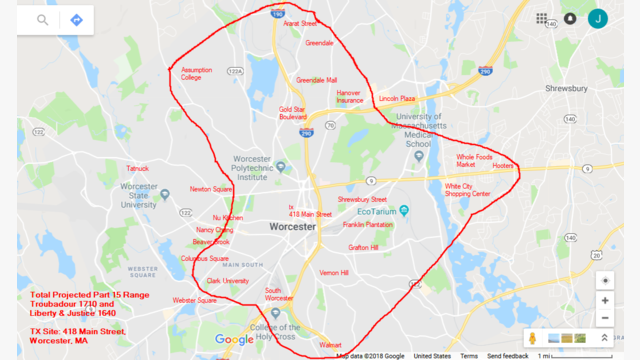Jeffrey Gill hasn't added a story.
Minimum Wage Media is seeking $3800 in funding to bring the micro signals of Troubadour 1710 and Liberty & Justice 1640 to downtown Worcester, Massachusetts.
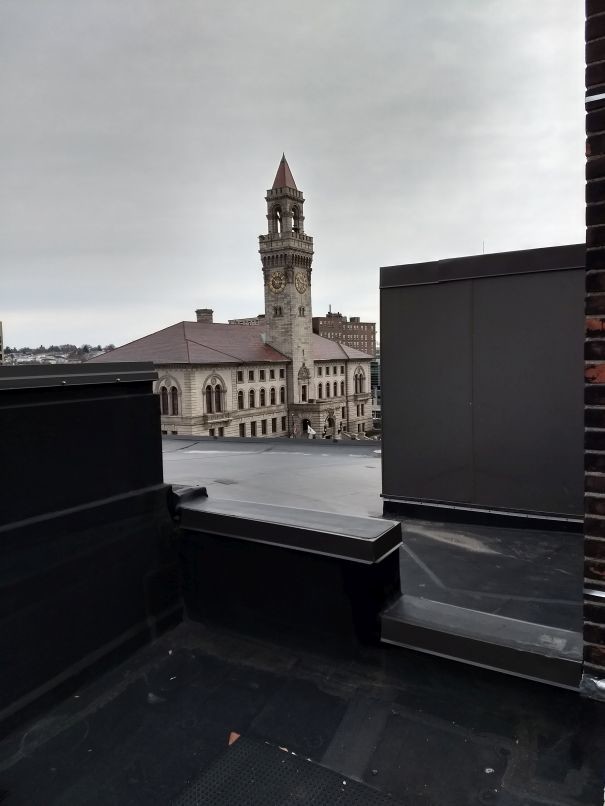 A view of Worcester City Hall from
the proposed transmitter site.
A view of Worcester City Hall from
the proposed transmitter site.
Introduction
When corrupt management eventually caused the demise of WADN in 1997, I lost all interest in continuing any involvement in radio that was not 100 percent on my own terms. I have neither volunteered nor been employed by a licensed broadcast enterprise since.
During the final days of WADN, a station intern and I pooled together our meager credit and purchased the station's music library for $5000. It happened hours before it was scheduled to be pawned off to a used record store. Utilizing the comparatively limited internet of the late 1990's, I began a website called Folk Image. I archived 2-hour shows compatible with early versions of RealPlayer that could be listened to on demand over a dial up connection.
As the 21st century commenced, there was an overdue backlash against big broadcast companies controlling so much of our media culture and discourse. This resulted in the establishment of the current LPFM radio service. But coinciding with that, and flying just under the radar, was a parallel movement called Part 15 radio. Part 15 is the section of the FCC rules that pertains to both intentional and unintentional radiations from various devices at various frequencies. With intentional radiators, this section defines the limits on power output and antenna structure in order for the radiations to be legal and not require a license. The original purpose of the Part 15 section of the rules was two fold: 1) prevent unintentional radiations from a wide variety of devices from causing objectionable interference with the broadcast spectrum, and 2) enable intentional broadcasting to receivers around a house or yard at very low power without obtaining a license. However, concerning the second purpose, clever engineers eventually discovered ways to maximize these signals - particularly in the AM broadcast band - that produce ranges of 2 miles and more while still being compliant.
It should be noted that broadcast licenses
(especially those for existing stations) are too difficult and
expensive for the average working person, small business, or small
organization to obtain, even for LPFM, and the lowest amount of power
the FCC will license on the AM band is 250 watts during daylight
hours. There are limited filing windows and the FCC has had a freeze
on applications for years now. The system was designed that way, not
to weed out the inferior (a cursory look at our nearest radio
communities - Leominster and Fitchburg - blatantly demonstrates that!)
but to favor those who are less likely to challenge the prevailing
power structure - whether culturally, politically, or scientifically -
because they would more likely be a part of it. If the license holder
has a history of unethical behavior, it's even easier to keep them in
line. So, for individuals and aspiring broadcasters of very limited
means, awareness of the threshold where no license is required is very important.
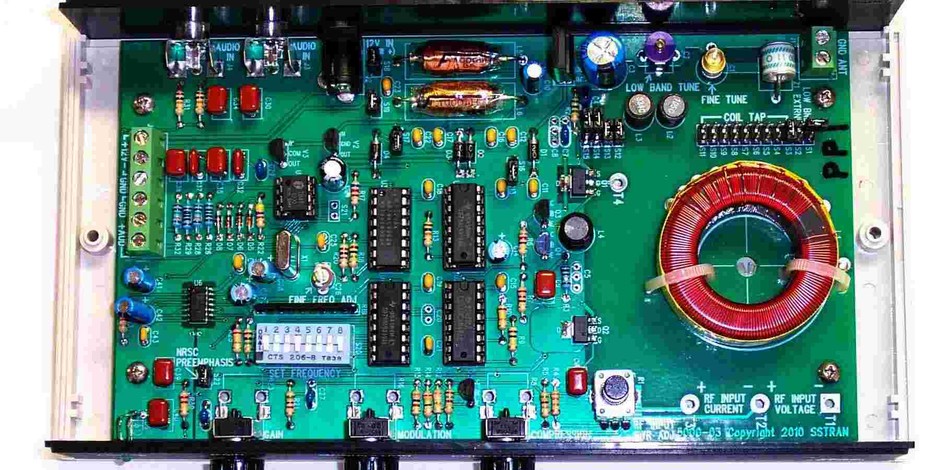 The assembled board of an
SSTran AMT-5000 Part 15 AM transmitter. I've
assembled two of these wonderful, economical, efficient units and
they serve as the workhorses of the flagship signals of Troubadour
1710 and Liberty & Justice 1640 in Shirley, MA. Unfortunately,
SSTran went out of business in November 2017.
The assembled board of an
SSTran AMT-5000 Part 15 AM transmitter. I've
assembled two of these wonderful, economical, efficient units and
they serve as the workhorses of the flagship signals of Troubadour
1710 and Liberty & Justice 1640 in Shirley, MA. Unfortunately,
SSTran went out of business in November 2017.
A number of factors came together that enabled the Part 15 broadcast hobby to emerge during the early years of the 21st century. First, in the late 1980's came the expansion of the AM band up to 1700 kHz, enabling a more efficient use of FCC mandated short antenna lengths for legal unlicensed broadcasting on this less-utilized band. Secondly, unlike the Part 15 rules for FM, the FCC requires no field strength limits at certain distances in order for an unlicensed AM operation to be technically legal. (Basically, the power to the final RF stage of the transmitter is limited to 100 milliwatts [1/10th of a watt], the total length of the antenna and the ground lead [but not necessarily the ground itself] is limited to 3 meters, and the antenna has to be directly coupled to the transmitter.) Third was the popularity of the "Talking House" transmitter, utilized by the real estate industry, which was the first widespread use of legal, unlicensed Part 15 broadcasting on the AM band. Improvements in signal coverage and audio quality were all that was required to retrofit Talking House transmitters into neighborhood broadcasting transmitters.
Also, in recent years, design engineers have advanced the technology with very efficient, full audio frequency response transmitters that squeeze practically every last milliwatt out to the antenna, instead of having a portion of the power lost as heat in the transmitter's final stage. Some of these transmitters come inside their own weatherproof housing so they can be directly coupled to an antenna to comply with FCC rules. Two were even tested by the FCC itself and awarded FCC certification, affirming that they are compliant with Part 15 rules and legal to operate without a license.
Even at the higher frequencies of the AM broadcast band, an antenna under 3 meters is still significantly too short to be an efficient match. But, when installed on top of a tall structure, either the structure itself, or the electrical ground wires running through the structure, act as a much longer radiator, creating a much more efficient transmitting system than a 3-meter antenna at ground level.
Unlike licensed LPFM, Part 15 operators do not have to form non-profit corporations and hold board meetings in order to get on the air. Interested individuals, DIY types, starving artists, ethnic groups, alternative programmers, and the working poor can go on the air whenever they are ready. There is no long, expensive FCC application process. There are no engineering studies, limited filing windows, lotteries, comparative hearings, attorney's fees, or other complications. And a well constructed Part 15 station, installed in a good, unobstructed, high location, can get nearly a third of the range of a licensed LPFM station.
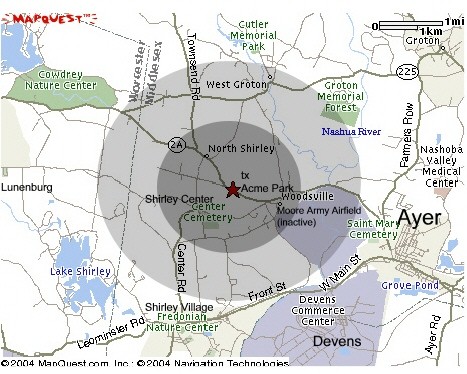 Approximate coverage of Minimum Wage Media's two current Part
15 AM stations, Troubadour 1710 and Liberty & Justice 1640,
during ideal conditions. Reception within the darker circle is
generally available at all times. Both operate with a power output
of 1/10th of a watt.
Approximate coverage of Minimum Wage Media's two current Part
15 AM stations, Troubadour 1710 and Liberty & Justice 1640,
during ideal conditions. Reception within the darker circle is
generally available at all times. Both operate with a power output
of 1/10th of a watt.
In 2004, I put Troubadour 1710 on the air on its original frequency
of 1700 kHz. With the base of a pipe antenna/external loading coil
combination about 17 feet above the ground (which is as high as I can
safely mount it on a single story mobile home), I get about two miles
of range with strong to moderate reception in the first mile and
moderate to weak reception in the second. The total cost to build the
station was $400 to $500 if you include the computer and the software.
I built and tweaked everything myself, from the transmitter kit and
the antenna system to the computers and the format itself. Liberty
& Justice 1640 followed in 2008. I've been running the stations
ever since with no interference complaints from neighbors, any
licensed station, or the FCC itself.
Although well known and liked by prominent town residents, primarily in the Shirley Center and North Shirley neighborhoods, the stations reach an area with a relatively sparse population and only a handful of retail businesses. Financial support is occasional to non-existent. Over the years I have worked full time, mostly in the food delivery and retail fields, in order to support myself and the stations. This has taken time I might have spent developing the potential there would have been in the surrounding neighborhoods, plus adding transmitters in downtown Ayer and Shirley Village. But the resulting degree of financial support would probably not have been worth it.
During mid to late 2016, I increasingly saw the need to make major changes in my work and social life. During that period, I began visiting Worcester on a regular basis. For a couple of years, I had become more aware of the city's increasing compatibility with my own needs and interests - more so than any other New England city in the current time frame. My perceptions have certainly been confirmed.
In January 2017, I took a position with Foodler/Dashed, a Boston based restaurant food delivery service which was launching a Worcester operation. The following month, I quit my Shirley-based job of 18 years and went full time with Foodler/Dashed. In October 2017, Foodler/Dashed was acquired by Chicago-based GrubHub. The pay was better, and there were benefits. I have been an employee driver with GrubHub since the acquisition. The work is far from trouble free. But for many reasons, it has turned out to be the best job move I have ever made.
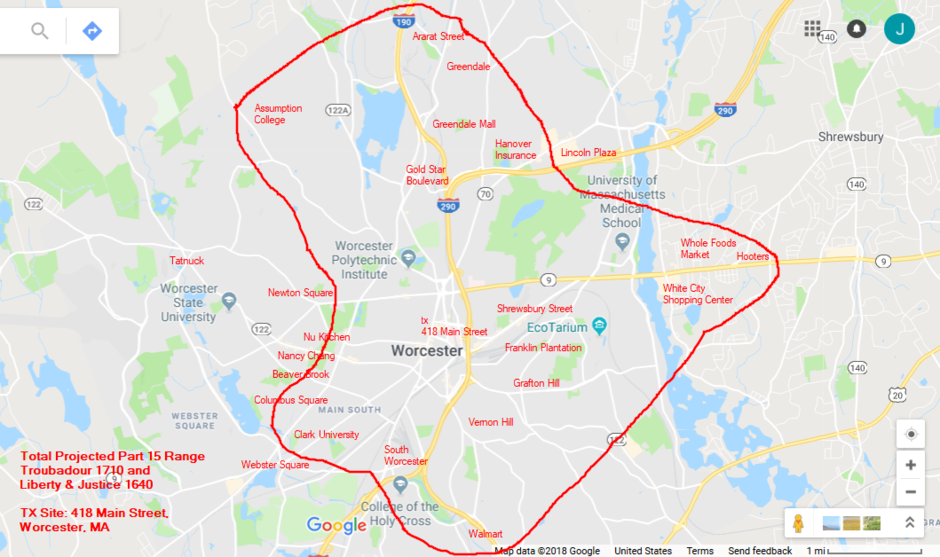 Total projected
range of Troubadour 1710 and Liberty & Justice 1640 from rooftop
transmitters at 418 Main Street in downtown Worcester. The coverage
is based upon the range of my rebuild of the Expresso 1620 (formerly
Expresso 1600) Part 15 transmitting facility at the same address.
The unusual, unintended directional pattern is a factor of the
city's three tallest buildings (the tallest of which is 24 stories)
all being located within a few hundred feet of the five-story
transmitter location.
Total projected
range of Troubadour 1710 and Liberty & Justice 1640 from rooftop
transmitters at 418 Main Street in downtown Worcester. The coverage
is based upon the range of my rebuild of the Expresso 1620 (formerly
Expresso 1600) Part 15 transmitting facility at the same address.
The unusual, unintended directional pattern is a factor of the
city's three tallest buildings (the tallest of which is 24 stories)
all being located within a few hundred feet of the five-story
transmitter location.One Sunday afternoon in early February 2018, I was performing a delivery to a customer in the South Worcester neighborhood when I spotted a white SUV parked on the street. On the passenger door it had a logo that said "Expresso 1600 AM." At first I thought the vehicle belonged to an out of state visitor because I knew of no "Expresso 1600" (most likely a Spanish language station) anywhere in New England or New York. I grabbed my phone and looked it up on line. It turned out to be a Part 15 station right in Worcester with their own website and internet stream. Up to that time, I had assumed there were no active Part 15 AM's operating in the city. I had heard of Radio Metabel at 1700 but was never sure I was receiving them or leftovers from WRCR in Rockland County, New York.
Expresso 1600's studio, office and transmitter were located
downtown at 418 Main Street. When I finally got close enough to hear
them, which was less than half a mile away, it became quickly
evident as to why I never discovered them during my drives around
town and scans of the AM dial. First of all, the frequency - 1600 -
is a poor choice for Part 15 operation in Worcester. Part 15
stations will have very limited range on frequencies that are not
totally clear, at least during daylight hours. Even weak leftover
signals on a channel will noticeably cut down the usable range. Only
the highest, clearest frequencies available are suitable for Part 15
use. Second, there was a terrible hum on the audio. I had heard that
kind of hum before and it is caused by something called a ground
loop. The number one cause of ground loop hum is using long runs of
unbalanced audio cable. A third problem occurred at any location
more than a few blocks from the transmitter. There was a terrible
"warbling" distortion noise on the audio whenever other
stations were present on the frequency. (I later discovered the
cause of this was a defect in the design of the Procaster
transmitter they were using.)
For the past year, I had been looking for a way to expand my
own operation into Worcester. I envisioned locating the transmitters
on one of the three tallest buildings in the city, if somehow I
could afford the rent or get it rent free through some kind of trade
deal. I also had a concern that a signal from any of the shorter
buildings might not get out at all, thanks to all the steel beamed
skyscrapers surrounding it. Nevertheless, not wanting to waste an
opportunity, I sent an email to Carmen Lounis, owner of ConeXMedia
Services, the Spanish language advertising production company that
operates the station. I introduced myself as a fellow Part 15
broadcaster who had built his own stations and that I was interested
in visiting her studio. Then I mentioned the technical problems with
the signal and audio. She replied that she was very interested in
meeting with me.
When I visited the station and took a tour of the roof, it quickly became evident what a disaster her transmitting plant had become. She had lost over $3000, including purchases she would never have made had her previous engineer known something about installing antennas and followed the instructions of the manufacturers. But since he didn't, her antennas blew down in strong winds, not just once, but twice. The first time, it half destroyed her original Procaster transmitting array. The second time, it destroyed a large specialty antenna she had purchased.
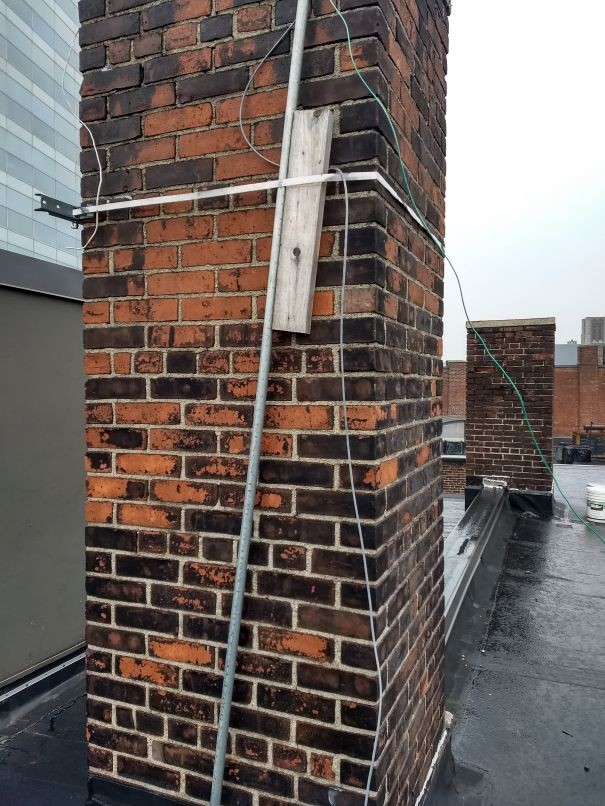
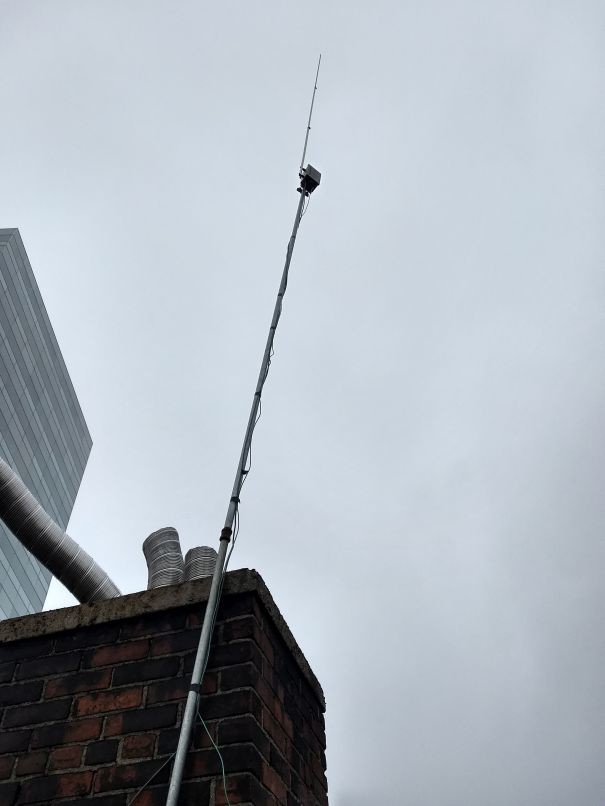 Here is a textbook example of how NOT to install an AM Part
15 transmitter. One of the chimney mounts had broken during a
previous windstorm. There is 20 feet of heavy rigid metal conduit
pipe with no guy wire support. The wiring is sloppy and
unorganized. Worst of all, the transmitter box is too high to
access for adjustments. Part 15 AM antennas can only be tuned
AFTER everything is installed in its final position. Although
height is desirable, the box MUST be accessible for tuning. This
box is certainly not.
Here is a textbook example of how NOT to install an AM Part
15 transmitter. One of the chimney mounts had broken during a
previous windstorm. There is 20 feet of heavy rigid metal conduit
pipe with no guy wire support. The wiring is sloppy and
unorganized. Worst of all, the transmitter box is too high to
access for adjustments. Part 15 AM antennas can only be tuned
AFTER everything is installed in its final position. Although
height is desirable, the box MUST be accessible for tuning. This
box is certainly not.
Carmen was desperate to find someone qualified who could rebuild her transmitting setup the right way. So she asked if I could do it. She was wondering how much I would charge. But my own desire to expand into Worcester and possibly integrate my transmitters into her operation complicated my offer. Also, at that point, I didn't know if I would be satisfied enough with the final result to make locating my own transmitters on that mere five story building - surrounded by skyscrapers - worth the expense and effort.
I ordered the necessary parts and in late February, there was a rare break in an otherwise severe New England winter. We had several days of no precipitation, calm winds, and temperatures in the 50's to near 60. Carmen had already given me the go-ahead to change the frequency to 1620, even though all of her logos and website were based upon 1600. To her, the best coverage was more important.
Although the skyscrapers had their predicted effect, the range turned out to be impressive for a station at the milliwatt level. (Review map above.) Since I was satisfied with the results, it appears that a Part 15 expansion with 418 Main as the transmitting site should be worth the expense and effort. And Carmen is willing to integrate my two transmitters into her operation as part of her rental of the property - but rent free for me - as long as I continue to maintain the Expresso 1620 signal, and design, build, and maintain any future expansions of her station.
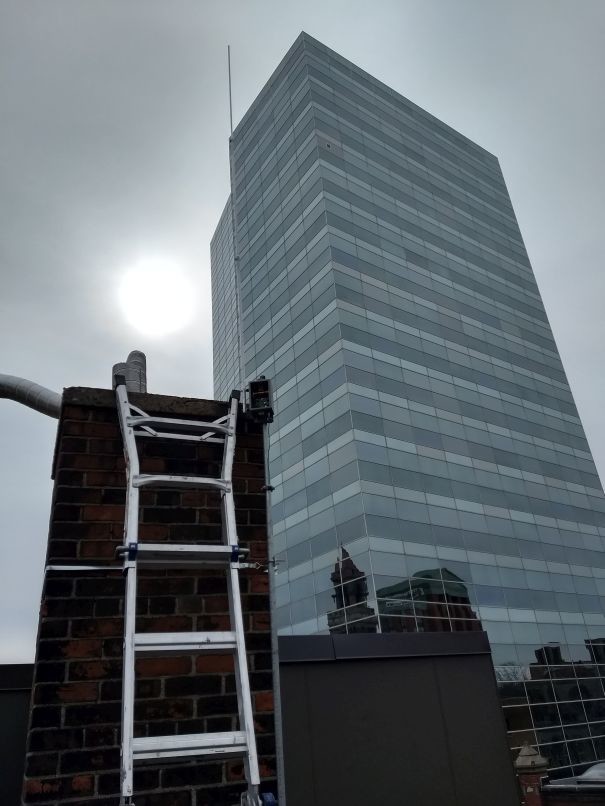 The new Expresso 1620 transmitter and antenna setup awaiting
the final steps of the installation. The Santander Bank tower (the
third tallest building in the city) is in the background.
The new Expresso 1620 transmitter and antenna setup awaiting
the final steps of the installation. The Santander Bank tower (the
third tallest building in the city) is in the background.
Among the expansions Carmen wants is at least one more transmitter in Worcester and a transmitter in the Lake Whalom area of Lunenberg. The Lake Whalom transmitter should produce just enough range to reach the downtown areas of Fitchburg and Leominster. It is also my intention to rebroadcast Troubadour 1710 and Liberty & Justice 1640 at the site as long as there is enough room for three antennas.
Local radio in Fitchburg-Leominster is so pathetic that even a Part 15 with intelligent programming has potential. I will be conducting another fundraiser to expand into that market when the time comes, should all the elements fall into place.
Set as ?
The campaign video will appear in social media and email.
The campaign cover picture will appear in social media and email.
The will appear at the top of your campaign page and in social media and email.
Reset ?
It will be removed from the top of your campaign and won't be used as default in social media and email. The will remain in the media gallery.
Share
Embed
Share a link
Delete update
Delete this story update?
Any pictures or videos will remain in the campaign's media gallery.
Report campaign
Report submitted
Thank you. We take reports like yours very seriously. Our goal is to keep the community safe.
Please know that we may contact you for more information, but that we won't notify you personally of our decision. If the campaign remains available within a few days, it's likely that we determined it not to be in violation of our policies.
Thank you. We've already received your previous report. If the campaign remains available within a few days, it's likely that we determined it not to be in violation of our policies.
Tell us about the problem. Please fill in both fields below.
Record a video
Upload a video
Nothing grabs attention for your cause like a personal video. Take a minute or two to record one now. Record a short video message of support. Or upload one from your device. You can preview or redo your video before you post it.
Nothing grabs attention for your cause like a personal video. Upload a short video message of support. Upload a short video message of support. Or record one right now.
- Most effective video length: about a minute.
- Maximum length: 5 min.
- You can preview or redo your video before you post it.
Heads up! The existing video will be replaced.
Email your friends
Join our team
Your endorsement banner
Use your endorsement banner to tell why our cause matters to you. Such personal endorsements are proven to increase campaign contributions. When enabled, your endorsement banner appears at the top of the campaign for everyone who visits a link you shared.
You can always adjust your endorsement from the campaign Share page—even if it's been disabled.
Your message
Tell people why our cause matters to you. Your personal message will encourage others to help. Easy, effective, optional.
Say it in video
Short personal videos by supporters like you are incredibly powerful. Record one right now and you'll help us raise more money. Easy, optional, effective.
Add a personal goal
Set a personal fundraising goal. You'll encourage more contributions if you do. And rest easy. There's no obligation to achieve your goal or bad consequences if you don't. Easy, optional, effective.
We have a video!
Video thumbnail
We'd love to show you our campaign video. Want to take a look?
, you're already on the team.

